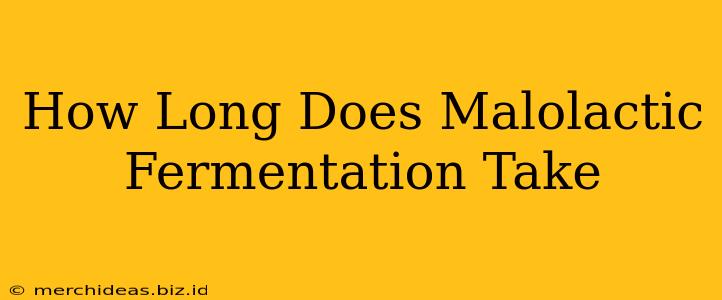Malolactic fermentation (MLF) is a secondary fermentation process in winemaking that converts malic acid into lactic acid. This process significantly impacts the wine's flavor profile, often resulting in a softer, rounder, and more buttery taste. But how long does this crucial step actually take? The answer, unfortunately, isn't a simple one. The duration of MLF is highly variable and depends on several factors.
Factors Affecting the Length of Malolactic Fermentation
Several key factors influence the length of time malolactic fermentation takes to complete:
1. Wine Temperature:
- Optimal Temperature: MLF typically occurs optimally between 60-70°F (15-21°C). At cooler temperatures, the process slows down considerably, potentially taking weeks or even months. Conversely, excessively high temperatures can inhibit or even kill the Oenococcus oeni bacteria responsible for MLF, causing it to stall or fail altogether.
2. Bacterial Strain:
- Specific Bacteria: Different strains of Oenococcus oeni exhibit varying levels of activity. Some strains are known for their rapid fermentation, completing MLF in a matter of weeks, while others are slower, potentially extending the process for several months. Winemakers often select specific strains to control the timing and outcome of MLF.
3. pH Level:
- pH Influence: The pH of the wine significantly impacts the activity of Oenococcus oeni. A lower pH (more acidic) generally inhibits MLF, while a higher pH (less acidic) promotes it. Wines with a high pH may complete MLF quickly, whereas more acidic wines may take longer or fail to undergo MLF altogether.
4. Sulfur Dioxide (SO2) Levels:
- SO2 Inhibition: Sulfur dioxide (SO2), a common preservative in winemaking, can inhibit or completely stop MLF at high concentrations. Winemakers carefully manage SO2 levels to ensure that MLF can proceed without undue delays.
5. Nutrient Availability:
- Essential Nutrients: Oenococcus oeni requires specific nutrients to thrive and complete MLF. Deficiencies in these nutrients can significantly slow down or even prevent the process. Winemakers may add nutrients to the wine to ensure adequate supply for the bacteria.
6. Wine Style and Composition:
- Varietal Impact: The grape variety, and thus the resulting wine composition, can affect the speed of MLF. Some wines are naturally more conducive to MLF than others. Factors like the initial malic acid levels and the presence of other compounds in the wine can impact the rate of fermentation.
Typical Timeframes for Malolactic Fermentation
While there's no single definitive answer, here are some general guidelines:
- Faster MLF: Under ideal conditions, MLF can be completed in a few weeks.
- Average MLF: For many wines, MLF takes several months.
- Slower MLF: In some cases, particularly with challenging conditions, MLF can take over a year.
Important Note: It's crucial to monitor MLF closely. Winemakers regularly test for malic acid levels to track progress and make necessary adjustments to ensure successful completion.
Conclusion: Patience is Key
The duration of malolactic fermentation is a complex interplay of several factors. While winemakers strive for efficient and timely completion, the process often unfolds at its own pace. Patience, careful monitoring, and a good understanding of the influencing factors are key to successfully navigating this important stage of winemaking. Understanding these variables helps winemakers create the desired flavor profile and achieve the best possible results from their wines.
